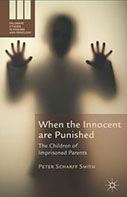When the Innocent are Punished: The Children of Imprisoned Parents

Author: Peter Scharff Smith
Publisher: Basingstoke, UK; New York: Palgrave Macmillan, 2014. 312p.
Reviewer: Kristin Turney | May 2015
Rising imprisonment rates across the globe mean that an increasing number of children experience the imprisonment of a parent. In the United States, it is estimated that 1.7 million children have an imprisoned parent. In the European Union, about 800,000 children have an imprisoned parent. In Denmark, between 4,000 and 7,000 children, the majority under the age of six, experience parental imprisonment on any given day. In many countries across the globe, there are more children of prisoners than prisoners. Therefore, Peter Scharff Smith’s book, When the Innocent are Punished: The Children of Imprisoned Parents, is a timely and important addition to the burgeoning literature on the causes and consequences of mass imprisonment for children.
This book is a compelling account of the processes through which parental imprisonment is consequential for children and makes three broad contributions to the literature. First, the author documents the challenges faced by children of imprisoned parents. The challenges, that begin with parental arrest and end with parental re-entry, are discussed from both the point of view of the children and other adults in the children’s lives (e.g., police officers, social service employees). Second, the author examines how children can maintain their rights, and how individuals connected to these children can help them maintain their rights, while their parent is under the supervision of the criminal justice system. Finally, the author investigates how prisons relate to broader societal processes. Taken together, the author makes the case that children of imprisoned individuals are an extremely vulnerable population who experience a number of (mostly) negative consequences (including a loss of human rights) resulting from their parents’ imprisonment.
One important contribution of this book is that the author provides a compelling framework for understanding the consequences of parental imprisonment for children. The author first presents an historical account of the modern prison system. In this account, he suggests that the prison system established in the 19th century, which provided a foundation for today’s prison system, plays an important role in challenging and destroying family life. He writes: “…this system cut off the prisoner’s important social relations and thereby often harmed all the people on the other end of these relations—prisoners’ spouses, children, parents and friends” (page 25). Second, the author reviews the growing body of literature on the effects of imprisonment on children. By and large this research shows that although parental imprisonment can sometimes have null or even positive consequences for children, parental imprisonment is, on average, associated with increased problem behaviors, lower educational achievement and attainment, and greater delinquency. Finally, the author investigates how imprisonment may affect the rights of children globally. Children’s rights can vary across countries, but most children have the right to have their best interests taken into account, the right to be heard, and the right to maintain contact with parents. He notes that although children, in theory, have a number of rights, the ways in which children can fully experience these rights is often dependent on their parents. The author writes that children’s rights are especially important during the case of parental imprisonment and that society should be cognizant of the challenges these children face.
Another important contribution of the book comes through the author’s reporting of results from three sets of empirical studies. The studies, conducted mainly in Denmark (but also in Northern Ireland, Italy, and Poland), involve the following: (1) ethnographic research in prisons, (2) interview-based research with individuals connected to children of imprisoned parents (including prison staff, police officers, and social service agency employees), and (3) archival research to understand human rights law. The author thus relies on a vast amount of data, collected across multiple years and countries, to document the challenges faced from parental imprisonment.
The key empirical findings from this book come from the author’s attention to how children experience parental imprisonment at various points during the process. Indeed, parental imprisonment is a process that usually begins with an arrest, progresses to the imprisonment (both before and after sentencing), and ends with re-entry. Throughout the book the author pays careful attention to how these various phases can independently influence children. For example, the author notes that in many cases, there are no standard ways that children experience parental arrest (and that these differential experiences can have differential consequences for children). Some children witness the arrest of their parent while others do not. Some children are told about the arrest of their parent while others are not. The author also describes the heterogeneous responses to parental imprisonment. He documents that the period before sentencing, for many children and families of the imprisoned, can be a period of intense uncertainty, and that in many cases sentencing brings a relief.
This book makes an important contribution to the growing literature on parental imprisonment and child wellbeing. But I have two unanswered questions. First, how does parental imprisonment differentially affect the rights and outcomes of children across the various countries? One of the strengths of this book is that the author uses data from outside of the United States. This is in contrast to the majority of research on parental imprisonment that focuses on the United States (which is understandable given the massive increases in incarceration in the United States and the extreme disparities between who is and is not incarcerated). But the author missed an opportunity to (1) describe the various political and social features of the four countries where data were collected and (2) make more explicit comparisons across the countries. I imagine the process of imprisonment—and perhaps the consequences of imprisonment —work differently across the different countries, and this would be useful for thinking about policy interventions. To the author’s credit, he is aware of this: “Another important question is to what degree research on children of imprisoned parents and the negative effects they experience translates across countries and jurisdictions. Societies, cultures, penal law, prison practices and social security are certainly different from place to place and must have an impact on the degree and kinds of problems children experience” (page 55). But some more attention to similarities and differences across countries would have increased the scope of the book. Second, I think it would have been useful if the author had systematically discussed the potentially different experiences of children of imprisoned mothers and children of imprisoned fathers. Certainly, there are quite a number of distinctions between the experience of paternal versus maternal imprisonment. In many countries, paternal incarceration is much more normative than maternal imprisonment. This suggests that (1) paternal imprisonment is more common and (2) there may be differential selectivity in maternal and paternal imprisonment. Additionally, the living situations of children seem likely to vary as between paternal and maternal imprisonment. For example, children of imprisoned fathers would seem to be likely to still live with their mothers, whereas children of imprisoned mothers may be more likely go to live with grandmothers or other relatives, or to be placed in foster care. Is this indeed the case?
In sum, this book contributes to the growing literature on the consequences of parental imprisonment for children. The focus on children’s human rights, as well as the careful attention to the various stages of the imprisonment process, distinguishes this book from others on the topic.
Kristin Turney, Assistant Professor, Department of Sociology
University of California, Irvine


